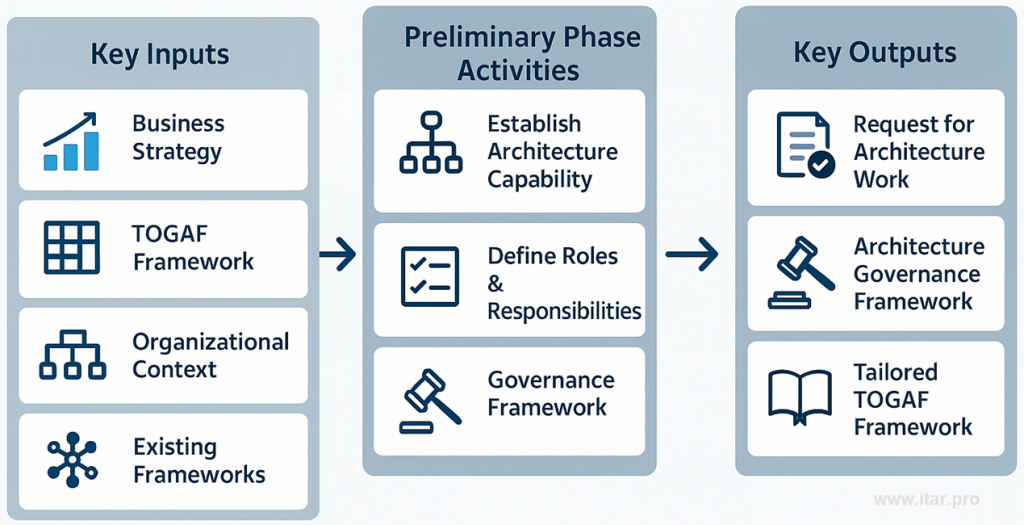The TOGAF Preliminary Phase is a critical initial stage for any enterprise architecture initiative. It is where the foundational work is performed to prepare an organization for a successful architecture project. This phase establishes the “how” and “why” of the architecture work before defining the “what.”
This article provides an in-depth overview of the purpose, key inputs, and core activities of the Preliminary Phase, aligned with the TOGAF Standard, 10th Edition.
Purpose of the Preliminary Phase
The Preliminary Phase is the foundational stage of the Architecture Development Method (ADM). Its primary purpose is to prepare the organization for a successful architecture project by establishing the Architecture Capability. This involves defining the organizational structure, processes, skills, and tools necessary to conduct architecture work and manage the architecture repository.
The phase addresses key questions such as: How will the architecture effort be governed? What is the business context being addressed? And which parts of the TOGAF framework will be tailored for the organization? By addressing these questions upfront, the Preliminary Phase ensures that the architecture work has a clear mandate, necessary resources, and full business support.

Key Inputs to the Preliminary Phase
Before the Preliminary Phase can begin, critical information must be gathered. Key inputs include:
- The TOGAF Standard: The framework itself is the most important input, as its concepts and modular structure will be tailored to the organization.
- Business Strategy and Drivers: High-level strategic documents such as the organization’s mission, vision, and long-term business strategy. Without this input, architecture work lacks purpose and direction.
- Organizational Context: Information about the company’s structure, culture, and key stakeholders. Understanding the existing landscape is crucial for gaining buy-in.
- Existing Architecture Frameworks: If the organization already uses other frameworks (e.g., Zachman, FEAF), they must be considered to ensure consistency and avoid conflict.
- Existing Architectures: An understanding of the current state of the architecture provides a baseline.
Establishing the Architecture Capability
Establishing an Architecture Capability is the central activity of the Preliminary Phase. This involves creating a self-sustaining function within the enterprise.
Defining Roles and Responsibilities
The definition of roles and responsibilities is crucial. Key roles typically include:
- Chief Architect: The strategic leader of the EA practice.
- Enterprise Architects: Responsible for the overall enterprise-wide architecture.
- Domain Architects: Specialists in the four architecture domains (Business, Data, Application, and Technology).
- The Architecture Board: A cross-functional group of senior leaders responsible for final decisions and ensuring governance.
Establishing the Governance Framework
Governance is a system of checks and balances that ensures architecture is implemented correctly and remains aligned with established principles. This involves defining a clear process for:
- Compliance Review: How architecture work will be reviewed against established principles and standards.
- Change Management: How proposed changes to the architecture will be handled and approved.
- Decision-Making Authority: Who has the power to approve or reject architectural designs.
Defining Architecture Principles
Architecture Principles are a set of high-level, foundational rules and guidelines that govern all architecture work. They are established in this phase to ensure that future architectural decisions are consistent, aligned with business goals, and easily understood by all stakeholders.
A good principle is not a vague statement; it should be understandable, robust, consistent, and complete.
Examples with Justification:
- Principle: Data is a Corporate Asset.
- Implication: Data should be treated as a shared resource, managed with high quality, and made accessible across the enterprise. This discourages data silos.
- Principle: Technology Independence.
- Implication: The organization’s application and data architectures should not be tied to specific vendor technologies. This helps avoid vendor lock-in.
- Principle: Business Imperatives Drive Technology.
- Implication: All technology investments must be directly traceable to a specific business need. This ensures IT delivers tangible business value.
Key Outputs and Deliverables
The successful completion of the Preliminary Phase results in several key deliverables that serve as the formal foundation for the rest of the ADM cycle.
- Request for Architecture Work: A formal document from the sponsoring organization that outlines the business need and requests the architecture team to begin a specific architecture project.
- Architecture Governance Framework: The documented system of governance that details the roles, responsibilities, and compliance review process.
- Tailored TOGAF Framework: The organization’s customized version of the TOGAF framework, which specifies which parts of the ADM to use, the specific terminology, and how to integrate it with other organizational processes.
Conclusion
The Preliminary Phase is a strategic necessity, not a formality. By investing time and resources here, a foundation is built that enables the entire ADM cycle to run smoothly, driving real business value.



